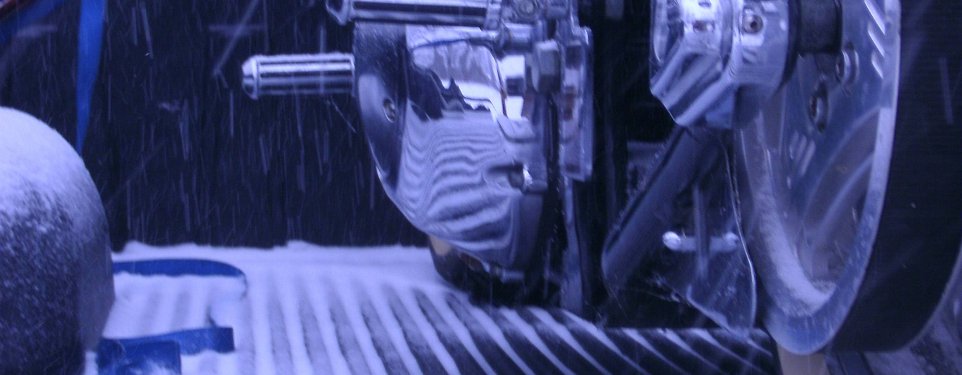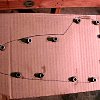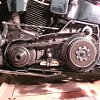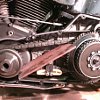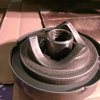Do I need to buy that? I find myself asking that lots and lots, and as a collector of rusty junk and purveyor of used parts, I answer "Yes!" probably more often than I should. This is a glimpse into the purchases and thinking of an average garage assembler/60 wt. junkie.
“1993 Harley Fat Boy. 25,108 miles. Fluids changed recently. Custom wheels and sprocket. Won’t go into gear. Make offer.”
That’s what I read on the craisglist ad, with a bad photo of a white bike in a basement. Why was I looking for Softails? I have a passel of bikes in the garage already that don’t get ridden nearly enough. I’d recently traded a chopper I built for a semi-complete kit bike with lots of parts in boxes. In that deal, I acquired a fat-tire frame I was uninterested in building, and a brand-new springer that was made overseas whose quality was questionable. I decided then that I would take the drive train (brand new Evo motor, still in the crate, new 6-in-a-5 transmission, and a very expensive BDL belt drive, new in the box) and transfer it all into a 90s-era Softail and have a bike with fresh running gear. This Softail fit the bill.
I called. The lady who answered the phone gave me a price that was really high for a bike that I assumed had, at worst, a blown transmission. I thanked her for her time, and bided mine. A few days later, I sent her an email that said that I was willing to pay her $2,700 for the bike as it sat, and I could come pick it up with cash.
I guess she got some pretty low offers, because on a Friday, she called and said she’d sell for my price. I suppose the bills must have been piling up! I told her I’d be there in the morning, so the next morning, amidst snow falling, I loaded my ever-patient wife and a ramp into my tired, old pick-’em-up truck, and we began the trek to go see it. When we arrived, we were greeted by a nice, older couple, and after talking to them, it sounded like the bike was having clutch problems. They said they’d brought the bike to a shop, and they adjusted the clutch, and it was OK for a little bit, but the clutch began slipping again and they parked the bike. I could see the clutch adjuster on the cable, and it was hanging by about three threads. I forked over some cash, they gave me a clean title that matched the frame, and we loaded the bike into the truck.
At this point it was snowing really heavily. Chopper people do weird chopper things and tooling around in the snow with a big bike in the bed of a two-wheel-drive pickup was my weird thing for the day. A trip to Dunkin’ Donuts at this point yielded a delicious breakfast, a happy wife, a few more inches of snow to travel through, and a better story. Safety be damned.
My good buddy Andy came over, and after helping me shovel (the only kind of Shovel I don’t like!) all the snow out of the driveway, we cleared a path into the shop. As we were moving the bike, we worked the transmission. She seemed to go into each of her five gears without issue and the wheel would lock up in gear, so we suspected a clutch problem.

With an Evo-powered bike, I like to look at a few things first. I saw that the “points cover” had screws in it, not rivets, as the factory used, so I know someone changed that item. Not a big deal. On a 20-year-old bike, odds are excellent things have been tinkered with over time. I also like to pull a pushrod tube clip and slide the pushrod tubes up and examine the pushrods. Adjustable pushrods are nice to have, but they mean someone was definitely into the engine at some point. This bike had its solid pushrods. That’s no guarantee that the engine was virginal, but a sign of very high probability that such was the case. Removing those requires rocker box removal, so most fellas will cut them out with bolt cutters and reinstall the “quickie”-type adjustable units.
A quick exterior assessment indicated Owner 1 loved the bike. I spied terrible — but expensive — billet wheels and a matching pulley, custom paint (touched up with off-color house paint by Owner 2) and nice straight pipes with an aftermarket, painted air cleaner. An aftermarket touring saddle was present, along with drag bars on high risers, billet grips and shift levers. The bike was probably really cool … in 1997. The big fenders had minor dent damage at the edges, but I had plans to cut them down past the damage anyway.
At this point, my mind was working. I could strip this bike down as I planned, or maybe I could just repair it quickly. Maybe flip it for a few bucks. Maybe I could ride it around. Maybe I could ride it for a season and then sell it. So I started ripping apart the primary. Better to see what you have, right?

One of the things I like to do when I remove a primary, or a larger side cover on a metric bike that has many different-length fasteners, is to make up a little cardboard diagram and put the bolts where they go as I remove them, so reinstallation is easy.

After spraying out all the goop and cleaning up the resulting Valdez-level spill, I was looking at the insides of a pretty nice-looking primary, with lots of life left on the adjuster shoe.
The first step to getting into the clutch to examine the friction plates and steel plates is to remove the compensator pulley. Since the motor actually spins opposite of the way this item tightens, you need to lock the tranny and motor together to create enough force to spin the pulley off. Normally, I use one of my felling wedges for cutting firewood to jam between the teeth and chain, but it was cold out, and the woodshed was about a million miles away. I found a piece of scrap stock I had used on a welding project, and it turned out to be a perfect fit where I needed it! I slowly rotated the clutch basket to get the teeth lined up so I did not damage anything, and popped off the compensator pulley.


Now, for clutch removal, right? Wrong. My lovely bride wanted to try out a new restaurant we’d been eyeing up, and as she dutifully accompanied me and helped me load up the bike, she could not be denied.
Next time, Dear Reader, we’ll see if I got a real easy fix on a cheap bike! A good buddy is a fabricator of top-notch caliber and we have talked about swapping my engine for his hardtail service at the end of this season - then I could build an HD-titled chopper with that drive train that’s taking up room in the shop. Or maybe I’ll sell this bike… or keep it as the ugly beater. Who knows? Chopper guys do weird stuff. Stay tuned…































 Riders Preferred Membership
Riders Preferred Membership
